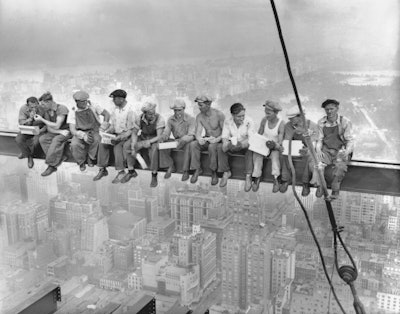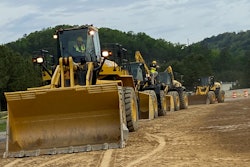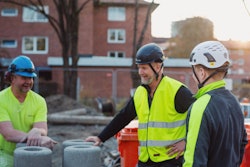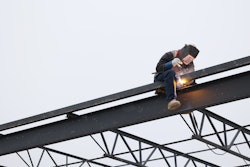
In one of the construction industry’s most iconic photographs, a group of construction workers perch precariously on a steel beam about 850 feet in the air above New York City, capturing both the industry’s bold spirit and the ever-present safety challenges that come with building the world’s most innovative and groundbreaking projects.
Construction safety culture has come a long way since the “Lunch Atop a Skyscraper” photo was taken nearly a century ago, including the introduction of required, basic PPE like hard hats and harnesses. But there are still many areas we must improve in order to drive a safer industry.
In fact, recent studies show that construction safety incidents are actually on the rise. When most people think of construction safety incidents, they typically think of accidents on site like falls or mishaps with equipment. These are some of the leading causes of construction fatalities, and we must continue to work to prevent them. But, one of construction’s least discussed and biggest safety challenges is often overlooked—death by suicide. According to the U.S. Centers for Disease Control and Prevention (CDC), the suicide rate for men in construction is five times greater than the rate for all fatal work-related injuries in the construction industry. This fact alone makes it clear that the only way we can improve safety outcomes in construction is to prioritize mental health just as much as physical health.
Paving the Way Toward a Safer Industry
According to the Bureau of Labor Statistics’ report on occupational injuries, fatalities increased 7.7% and suicides increased 13.1% from 2021 to 2022. Construction has one of the highest suicide rates of any industry, and this is largely attributed to factors like long hours, grueling completion schedules, and job-related risks of serious injuries, not to mention mental health often being stigmatized. On top of this, the labor shortage continues to put undue pressure on construction workers and is often linked to why all kinds of safety incidents are on the rise.
That’s why some construction leaders are beginning to invest heavily in initiatives and partnerships focused on mental health. Fred Mills, founder of The B1M, has become a leader in this space after sharing his own mental health journey and co-launching Get Construction Talking last year, an initiative from The B1M and Procore that focuses on breaking the stigma around mental health, getting millions talking, and raising $1 million for charities working to improve mental health in construction. The message behind the campaign is simple: One of the best first steps we can take in tackling the mental health crisis in construction is to start talking about it. By doing so, we can help destigmatize the topic and create a more supportive industry.
Ryan Companies’ CEO Brian Murray has similarly led by example by sharing his own story and helping change the narrative around mental health. In his talk at a TEDx event, “Addressing Mental Health in the C-Suite,” Brian shared how he has long battled depression and gave hope to those similarly struggling with their mental health.
Other industry leaders have built robust safety programs and industry partnerships solely dedicated to improving mental health in construction. MiCiM Ltd’s Commercial Operations Manager Lisa Taylor shared, “Health and safety is paramount in the construction industry and so it's paramount for MiCiM. We have really invested in our mental health awareness at work. We have a team and committee that meets and talks about mental health so we can keep it in the spotlight and give advice on how we can best look out for our colleagues and the signs to spot if they are just a little bit off or possibly suffering with their mental health.”
In addition, Bechtel recently committed $7 million to the American Foundation for Suicide Prevention—the largest donation they’ve ever received and a great example of how some of the industry’s biggest leaders are dedicating meaningful resources to address this crisis. Bechtel’s donation will provide critical resources and programming to 500,000 U.S. construction workers over the next five years.
What’s most encouraging is that both large and small construction companies alike are beginning to invest in mental health and integrate it as a key part of their safety culture. The more we do so, the safer and more supportive the entire industry will become.
Tackling the Labor Shortage Through Mental Health Initiatives
Clearly, there is incredible work being done to address the mental health crisis in construction, and these are just a few examples of how the industry is taking steps in the right direction. Not only is this the right thing to do, these initiatives can also have a direct impact on businesses’ bottom line.
Several studies demonstrate that when employees feel supported and are happier at work, businesses see an increase in productivity, creativity, and retention. On the flip side, when employees are dealing with mental health challenges coupled with long, grueling work days, businesses can see an increase in mistakes—increasing both the likelihood of rework and accidents happening on site. The mental health cost calculator released by the National Safety Council and NORC at the University of Chicago show that organizations that support mental health see a return of $4 for every $1 invested.
While any business can benefit from mental health initiatives, the impact of these programs on construction is even greater. As the industry continues to face the skilled labor shortage, building a healthy workplace culture is one of the best ways to retain current workers and attract future workers.
Not only that, but these initiatives can also help attract more folks from a diverse set of backgrounds into construction, driving a pipeline of workers for years to come. And, greater diversity fosters innovation and more inclusive practices, which can help drive a safer industry. The reality is, when we have more diverse folks in the industry, we build safety practices with everyone in mind, which can help drive a safer industry overall.
Insurate Chief Risk Officer Abby Ferri said, “If an employer asks their new employee for their PPE sizing and preference on Day One, they’re demonstrating the value of their employee’s input. On the flip side, if a new employee is handed a ‘one size fits all’ PPE with no other option, they may feel like they’re being treated as just a number. Studies have shown that when organizations build their PPE purchasing policy around the end user, it’s more likely to match the job scenario, be properly worn and maintained.”
This is just one example of how a seemingly simple gesture can have a powerful ripple effect. Ultimately, if the industry is going to tackle the labor shortage, it must prioritize mental health as much as physical health. Just imagine what we could accomplish together if we not only had a safer, more supportive industry but also the skilled labor to actually drive this mission-critical work forward.
The Time To Act is Now
Embracing mental health as part and parcel of safety culture doesn’t just start at the top—it’s a collective effort by each and every employee to create a workplace where everyone can thrive. We must do so by:
- Starting the conversation: This helps break the stigma and creates an environment where folks feel psychologically safe to ask for help.
- Providing employee resources: Not only does this include offering resources and support, such as employee assistance programs and mental health hotlines, but it also includes training employees to recognize the signs of mental health issues.
- Lead by Example: Every employee has a part to play in prioritizing mental health—whether it’s advocating for more robust safety programs, implementing mental health into the organization’s safety strategy, or bringing safety practices to life on a daily basis.
The stakes in the industry have never been higher to get this right. From the skilled labor shortage, to supply chain challenges, to the rapid change of innovation, it’s clear if we’re going to continue to make progress and drive the industry forward, we must start with the folks who are actually building the world around us.
The reality is, we can’t afford not to prioritize our people and take a holistic approach to worker well-being. We must continue to work together to create healthier workplaces that embrace mental health as the cornerstone of construction safety culture.




















